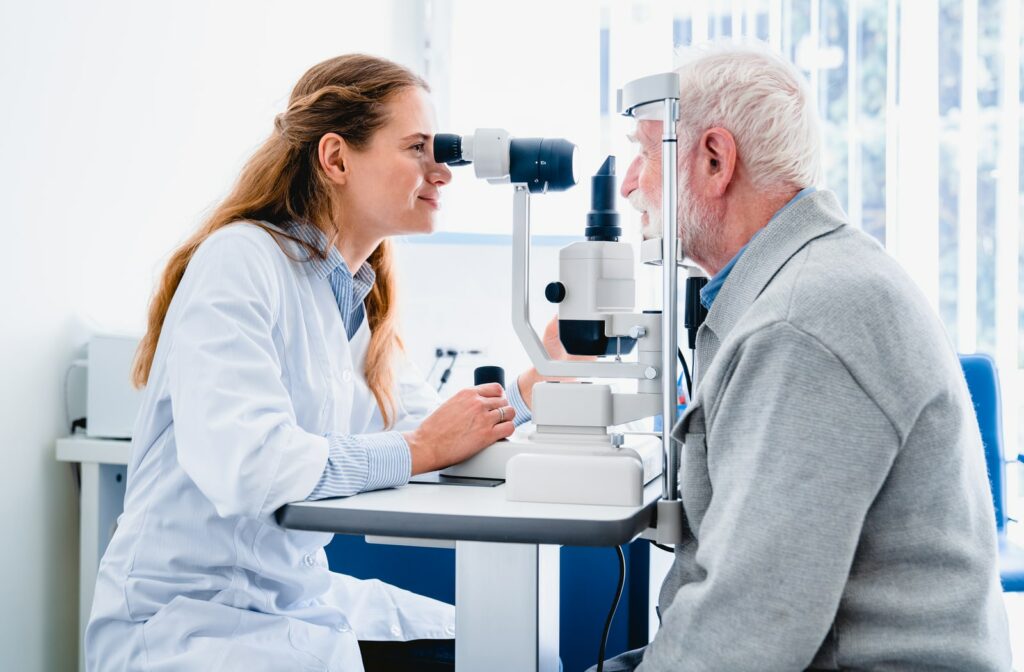Healthy eyes and vision are crucial for everyday life. Comprehensive eye exams provide a complete picture of your eye health. An eye exam forms part of preventative care, ensures optimal vision and prescription, and detects eye diseases that might go unnoticed if not done regularly.
With age, your eyes continue to change. Many people aren’t aware that eye conditions can sometimes develop with little to no symptoms until vision is affected. Thus, the Canadian Association of Optometrists recommends the following frequency for eye exams:
- Infants and Toddlers (Birth to 24 months): First eye exam
- Preschool Children (2 to 5 years): At least one eye exam
- School Age Children (6 to 19 years): Annual eye exam
- Adults (20 to 39 years): Eye exam every 2 to 3 years
- Adults (40 to 64 years): Eye exams every 2 years
- Adults (65 years or older): Annual eye exam
During an eye examination, your optometrist can examine the whole eye, inside and out, to diagnose, treat, and manage any eye conditions before they affect your vision. This article discusses the different eye conditions and some health conditions that eye exams detect.
Tests Conducted in an Eye Exam
Your eye exam starts with discussing your family history, work and home lifestyle, and several diagnostic tools or tests to get a complete picture of your eye health. These tests can include:
- Visual acuity
- Refraction testing
- Glaucoma testing
- Eye health evaluation
- Eye muscle evaluation
Eye Conditions That an Eye Exam Can Detect
Some common eye conditions that comprehensive eye exams detect are the following:
Strabismus
Comprehensive eye exams in children can detect strabismus or crossed eyes early by looking at how the eyes focus and move. If strabismus is left undetected or untreated, it can lead to a lazy eye or amblyopia.
Refractive Errors
Refractive errors are sight problems caused by an error in the shape and structure of your eyeball. Light focuses in front and behind the retina instead of directly on it. 4 types of refractive errors are:
- Nearsightedness or myopia
- Farsightedness or hyperopia
- Astigmatism
- Presbyopia
Glaucoma
With a family history of glaucoma or if you are high risk, you may need an eye exam more frequently. Glaucoma occurs from damage to the optic nerve at the back of the eye and can cause vision loss or blindness. There is no cure, but early treatment can prevent further damage to your eyes.
Since glaucoma develops gradually, you may not notice symptoms. The best way to diagnose glaucoma is with a comprehensive eye exam. Many people with glaucoma can have increased eye or intraocular pressure.
Dry Eye Disease
Dry eye disease is a condition that results from a lack of tear flow or quality. Tears are necessary for the health and function of your eyes. An imbalance in tear flow can cause problems in your eyes and lead to symptoms such as itching, burning, and a gritty sensation.
If you experience dry eye symptoms, an eye exam can determine the underlying cause. A dry eye exam includes measuring tear volume, quality, rate of production, and evaporation.
Diabetes
You can have diabetes and not even know it. Surprisingly, you can detect diabetes through a comprehensive eye exam. People with diabetes often have an eye condition called diabetic retinopathy.
Diabetic retinopathy, due to high blood sugar, damages the tiny blood vessels in your eye and causes them to leak fluid or bleed. High blood sugar, over time, can also damage the retina.
Retinal Conditions
A retinal exam looks at the back of the eye, the retina, the optic nerve, and the retinal blood vessels. This exam can check for the following retinal conditions:
- Retinal tears
- Retinal detachment
- Macular degeneration
Cataracts
Cataracts can occur in almost everyone as they age. It can develop slowly, rapidly, and even in babies. Cataracts affect your vision because the clear lens becomes cloudy. Eye exams, including history, symptoms, and dilation, help your eye doctor detect cataracts and determine the extent of vision loss.
Health Conditions Eye Exams Detect
Apart from eye conditions, comprehensive eye exams can also detect other health problems, such as:
- Diabetes
- High blood pressure
- High cholesterol
- Brain tumours
- Aneurysms
- Parkinson’s disease
- Multiple sclerosis
- Rheumatoid arthritis
Eye Health Starts with Eye Exams
Regardless of your overall health, a comprehensive eye exam is a process of evaluating the health and function of your eyes. Regular eye exams or the frequency determined by your eye doctor can identify visual concerns and eye conditions early.
Your eyes deserve care. Start by booking your eye exam at Maple Ridge Eye Care today.


